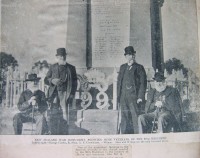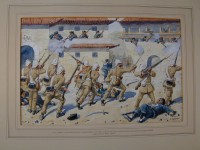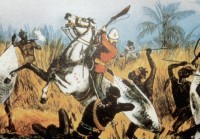Home of the Infantry Regiments of Berkshire and Wiltshire
The 99th (Lanarkshire) Regiment 1824-1881
This section summarises the main events in the development of the Regiment from its foundation up to the time of its amalgamation in 1881. For further information see The Story of the Wiltshire Regiment (Duke of Edinburgh's), The 62nd and 99th Foot (1756-1959). N C E Kenrick, 1963.
1824 Resurrection of the 99th Regiment of Foot

99th Regiment - four old soldiers of the Regiment who fought in the Maori Wars of 1845 – 1846
The first “99th” were embodied in Salisbury in 1760 and disbanded three years later. The second “99th” was raised in 1779 in the Midlands by public subscription for service in Jamaica, being disbanded at Woolwich in 1783. The third were formed at the outbreak of the French Revolution in 1793. They saw service in Guiana, on the North coast of South America, part of which the British were in the process of wresting from the Dutch. This Regiment of the “99th were disbanded about the turn of that century.
The fourth and fifth Regiments had a most complicated numbering. The fourth “99th” were raised Ireland in 1803, on the renewal of the war with France, and entitled “The Prince of Wales’s Tipperary Regiment,” serving in the West Indies and in Canada. In 1815 the Rifle Brigade, who were the 95th, ceased to be a Regiment of the Line, and all those junior to them came down one number. This made the Tipperary Regiment the 98th and they were disbanded in Chatham three years later. In 1815 the 100th of Foot, H.R.H The Prince Regent’s County of Dublin Regiment, became the fifth Regiment to bear the Number “99” before also disbanding in 1818 in Chatham.
The 99th (the sixth Regiment of Foot to bear that number) was formed for general service in Glasgow in 1824 following the request of the Governor of Mauritius for reinforcements. It became the 99th (Lanarkshire) Regiment in 1832. Remaining in Mauritius until 1837 the 99th then left for Ireland. From 1841 to 1843 it moved in several detachments to Australia, with the troops acting as guards on convict ships. In 1845 the Regiment was part of a force sent from Australia to New Zealand to take part in the First Maori War. Early in 1845 the trading centre of Kororarika in the northern part of the North Island, was sacked and the flagstaff cut down by Honi Heke Pokai of the Ngapuhi, this was later referred to as ‘The Flagstaff War’ The flank companies of the Regiment were dispatched from Australia under the command of the Commanding Officer Lieutenant Colonel Despard. This was a hard campaign against a resourceful and brave enemy; the main actions fought by the 99th took place at Ohaeawai ‘Pa’, the expedition to Ruapekapeka, and operations in the valley of the Hutt. The campaign lasted for more than two years before the Regiment returned to Tasmania. The 99th sailed for Ireland in 1856, leaving behind in Tasmania over 400 men who transferred to other regiments. Many of these eventually settled for good in Australia and New Zealand.
1858 The Wars in China

The Regiment's capture of Chang Chai-Wan during the 2nd Chinese War
In 1858 the Regiment went to Calcutta without their families as a result of the aftermath of the Indian Mutiny. In India they suffered dreadfully from fever resulting in many deaths. In 1860 the 99th was part of an Anglo-French expedition to China. This expedition came about because three years previously the Chinese had seized a British ship off Canton, which port the British then took, having declared war on the Tartar Dynasty. In 1858 the British had captured the Taku Forts on the coast east of Pekin, and the Chinese agreed to negotiate a peace, but broke their word and fired on the British envoys. At Tingaae, the capital of Chusan, the Regiment was billeted in joss houses for six weeks, with the officers enjoying shooting expeditions and parties. In September of that year they took part in the march to Pekin fighting one of the main actions at Chang-Chia-Wan. In October the 99th participated in the sacking of Peking. A small Chinese lap-dog (the kind now called Pekinese) was among the trophies of war and was named "Lootie". Brought to England by Captain J H Dunne it was one of the first dogs of its type to be seen in Europe. The dog was given to Queen Victoria and was later painted by Sir Frederick Keyl . Five vases acquired at the same time are now on display in the Museum. After the main campaign the Regiment remained in Canton for nearly a year where the Light Company were dispatched to Shanghai to fight some Taiping rebels.
1865 Title "Duke of Edinburgh's Regiment"

HRH Prince Alfred, The Duke of Edinburgh, second son of Queen Victoria
The 99th Foot arrived in South Africa in 1865 and remained for four years. During this time it was responsible for providing the garrison on the island of St Helena. It was reunited in South Africa at the end of 1868.
His Royal Highness Prince Alfred, Duke of Edinburgh, second son of Queen Victoria, took a great interest in the 99th, starting in Cape Town in 1868 when, as Commander-in-Chief of the Mediterranean Fleet, he inspected them at his own request. He presented them with new Colours at Aldershot in 1870. In 1874 permission was granted for the Regiment to be styled "The 99th (Duke of Edinburgh’s) Regiment" omitting the county title, and to bear the Duke’s cypher and coronet on the Regimental Colour. It still maintained its association as a Lowland Regiment, and sometimes wore a diced border on its Glengarry caps until these were replaced by the Field Service Pattern side hat.
1879 The First Zulu Wars and The Final Years
After serving in Ireland the 99th returned to South Africa in 1879 to take part in the Zulu war. The Battalion landed at Durban in January, 900 strong. Leaving two companies to garrison Durban and Stanger, the Regiment concentrated with the 1st Division on the Lower Tugela River at the Southern end of Zululand. Lord Chelmsford then invaded with three columns, his objective being the Royal Kraal at Ulundi.
Severe fighting followed, with the British better armed but outnumbered by 40,000 warriors of splendid physique, courage and discipline. The centre column under Lord Chelmsford was severely defeated on 22nd January at Isandhlwana and a detachment hard pressed in the defence of Rorke’s Drift. The left column with Colonel Evelyn Wood had to go on the defensive after the disaster in the centre, in case of a Zulu invasion of Natal.

Private Carson, one of the mounted infantry soldiers ambushed by Zulus March 1879
Colonel Pearson on the right advanced with his column on Ekowe, a mission station about thirty-five miles North of the Lower Tugela. With him were Lieutenant Colonel Welman and two companies of the 99th, who acted as Advanced Guard as they crossed the Inyoni River on 19 January. Three days later the Buffs heavily defeated a Zulu force on the Inyezane River, the 99th Detachment protecting the transport, and the column reached Ekowe after beating off an early morning attack, and started building a fort and other defences. Colonel Pearson sent some of his force to Natal on the threat of Zulu invasion and his remaining 1,300 men now invested in Ekowe by a Zulu Army, who made no direct assault but prevented any access to the Garrison. The 99th’s Detachment were 400 strong and engaged in outpost duty, raids on Zulu Kraals for food, and skirmishes
After the disaster of Isandhlwana reinforcements poured out from England, and Lord Chelmsford collected 6,000 men, including the remainder of the 99th. In the middle of March communications with Ekowe was established by heliograph. On 02 April a 10,000 Zulu assault was repulsed mainly due to the casualties caused by rifle and gatling fire. In July, Lord Chelmsford defeated nearly 15,000 Zulus near Ulundi, the 99th engaged on Garrison and escort duties.
Early in 1880 the 99th were posted to Bermuda though it was back in South Africa in 1881, when under the Cardwell reforms it ceased to exist as a separate regiment, becoming the 2nd Battalion of the (Duke of Edinburgh’s) Wiltshire Regiment.
A permanent Regimental Depot was established at Le Marchant Barracks, Devizes. The barracks were named after John Gaspard Le Marchant, who only commanded the 99th for a short period in the 1840s, but achieved great prestige for himself and his regiment.